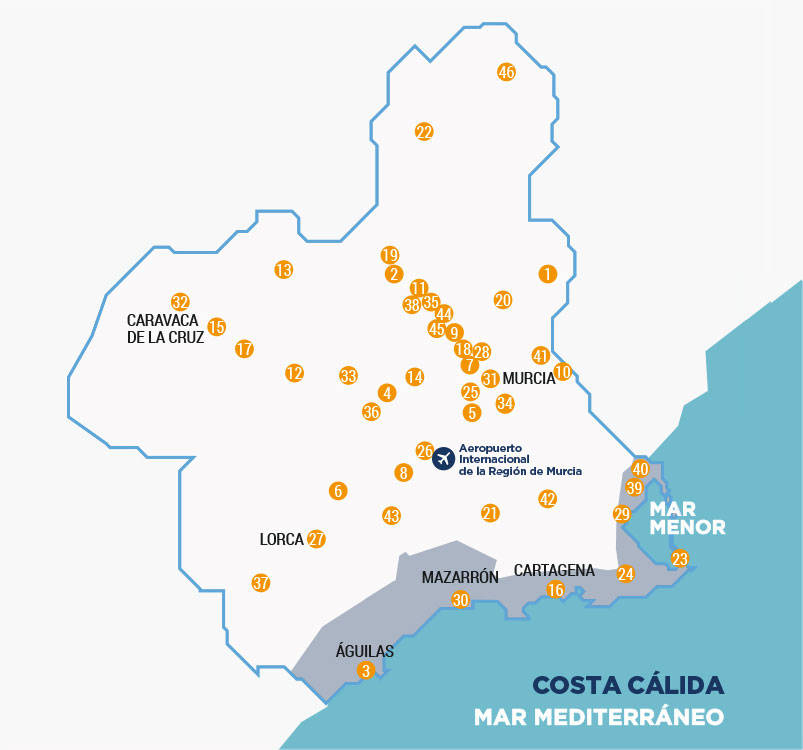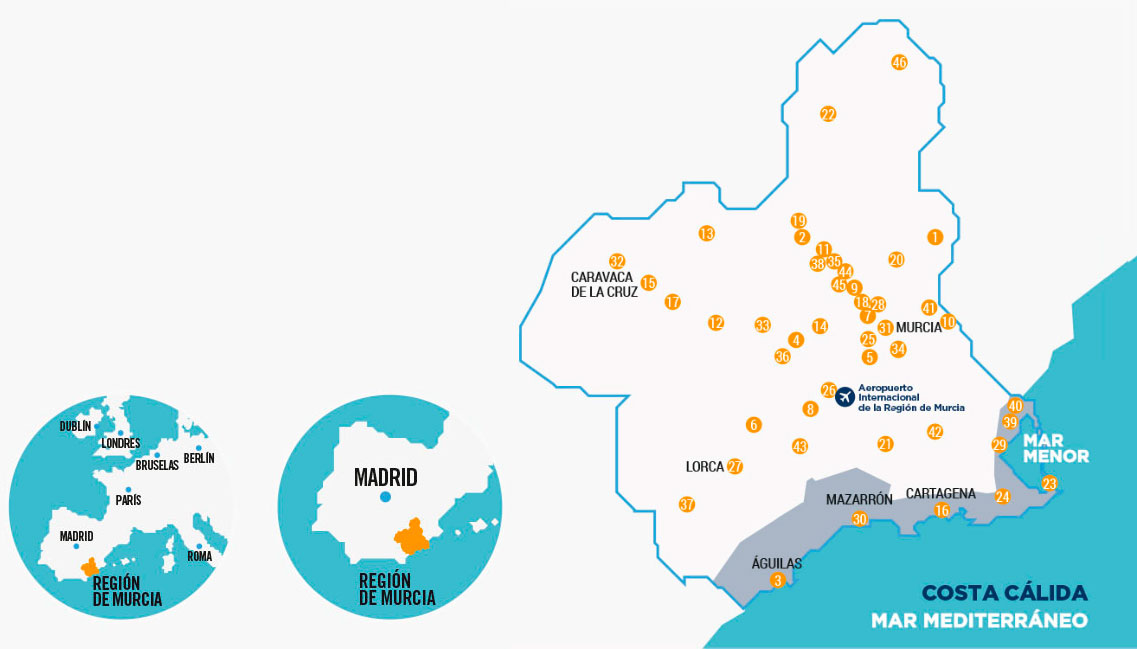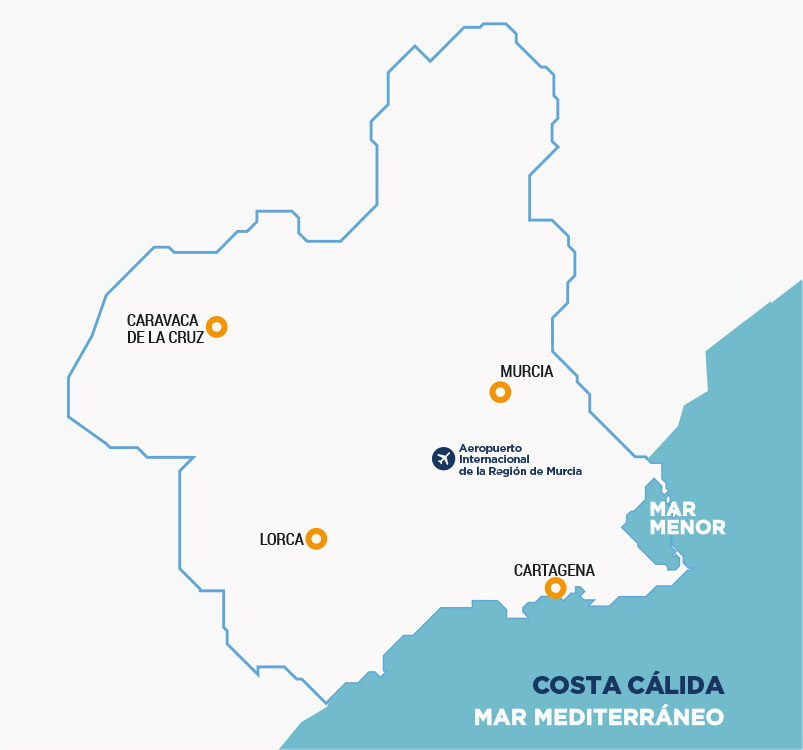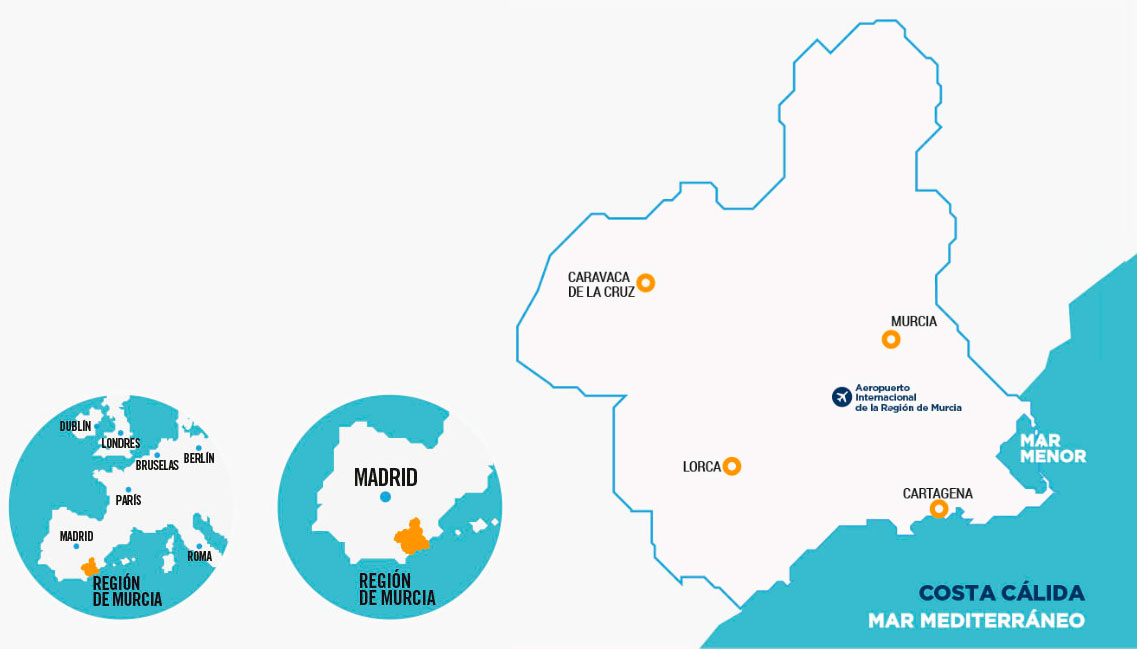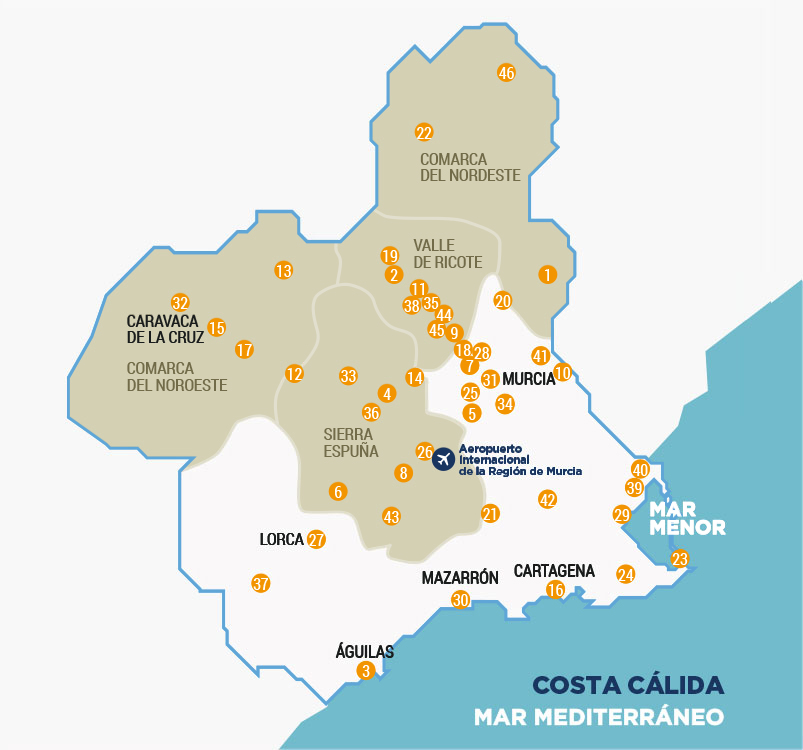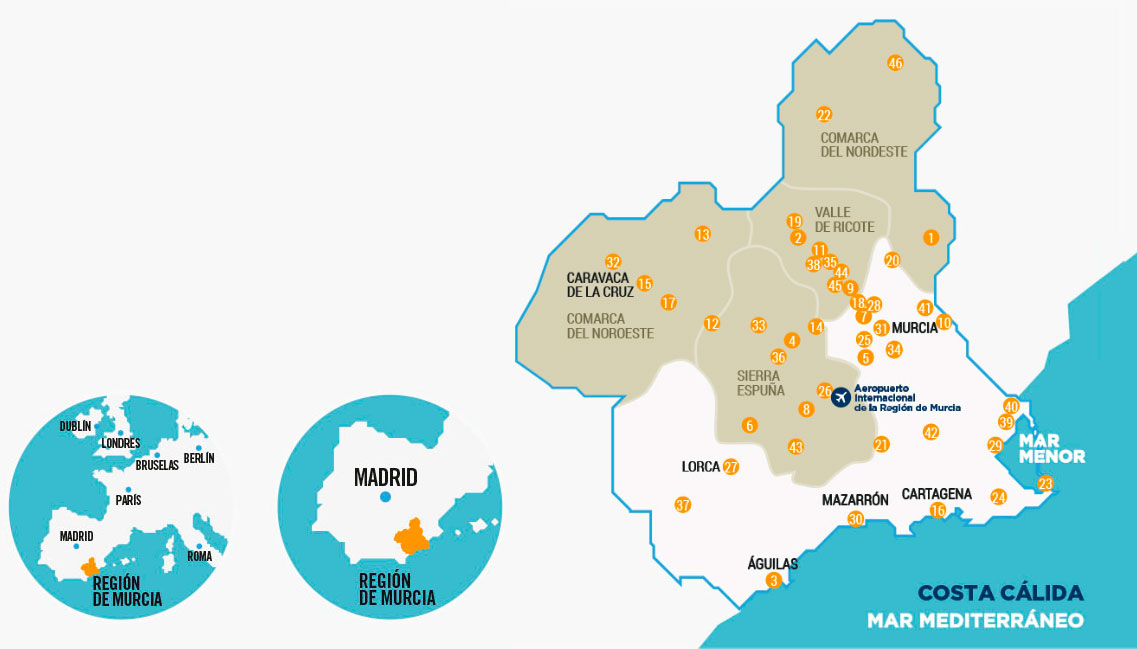Destinations and Localities
LOCALITIES
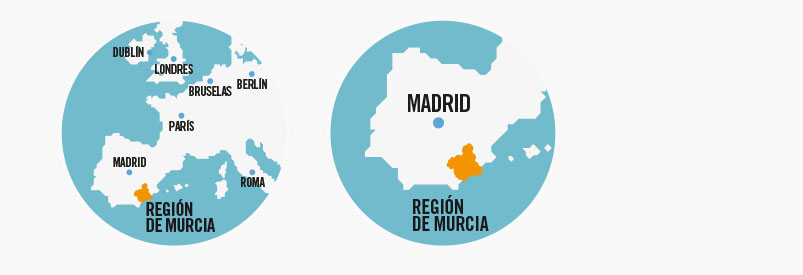
- 1 ABANILLA
- 2 ABARÁN
- 3 ÁGUILAS
- 4 ALBUDEITE
- 5 ALCANTARILLA
- 6 ALEDO
- 7 ALGUAZAS
- 8 ALHAMA DE MURCIA
- 9 ARCHENA
- 10 BENIEL
- 11 BLANCA
- 12 BULLAS
- 13 CALASPARRA
- 14 CAMPOS DEL RIO
- 15 CARAVACA DE LA CRUZ
- 16 CARTAGENA
- 17 CEHEGÍN
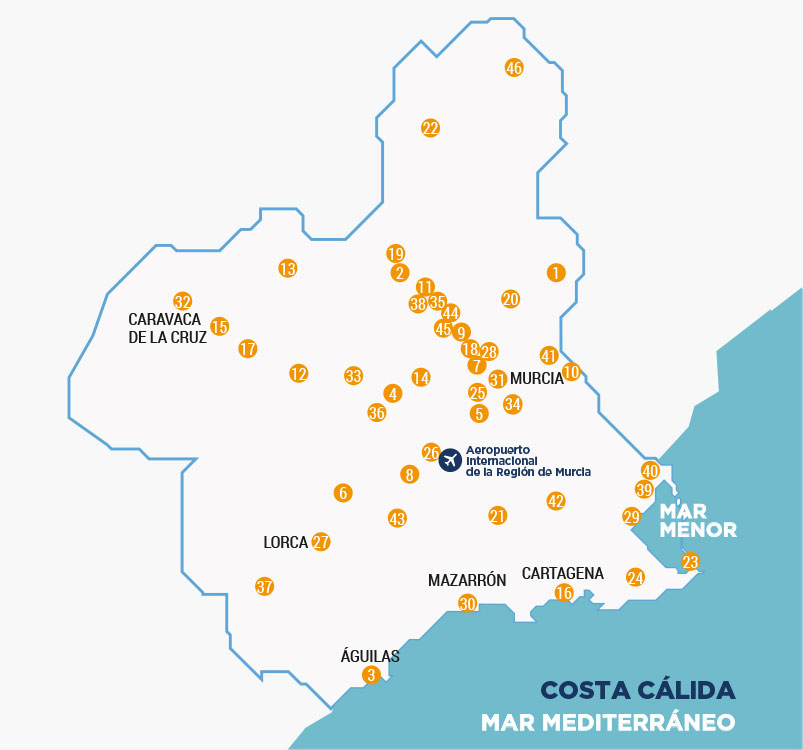
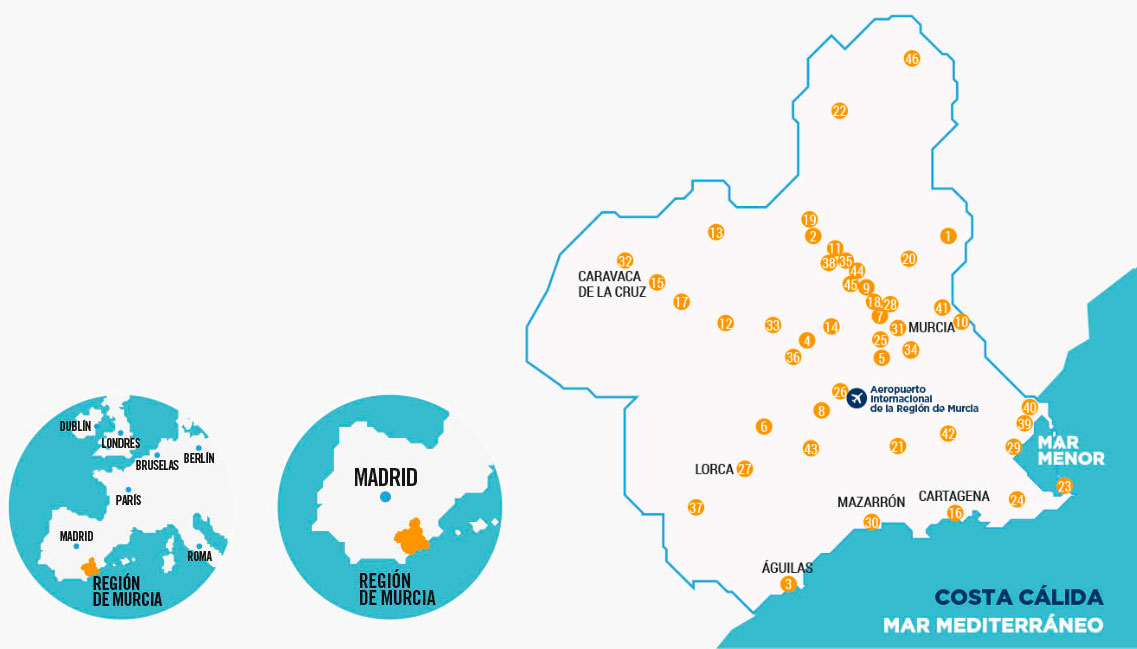
- 1 ABANILLA
- 2 ABARÁN
- 3 ÁGUILAS
- 4 ALBUDEITE
- 5 ALCANTARILLA
- 6 ALEDO
- 7 ALGUAZAS
- 8 ALHAMA DE MURCIA
- 9 ARCHENA
- 10 BENIEL
- 11 BLANCA
- 12 BULLAS
- 13 CALASPARRA
- 14 CAMPOS DEL RIO
- 15 CARAVACA DE LA CRUZ
- 16 CARTAGENA
- 17 CEHEGÍN
- 18 CEUTI
- 19 CIEZA
- 20 FORTUNA
- 21 FUENTE ÁLAMO
- 22 JUMILLA
- 23 LA MANGA
- 24 LA UNIÓN
SEASIDE
CITY
RURAL AREAS
Interactive Map
Get to know the Region
About the Region
Location
BACK
Located at the South-East corner of the Iberian Peninsula, between the regions of, Andalusia, Castile-La Mancha and Valencia, the Region of Murcia occupies an area of 11,317 km2 (2.2% of the total surface area of Spain), bordering the province of Albacete in the North, the province of Alicante in the East, the provinces of Granada, Albacete and Almería in the West, and the Mediterranean in the South-East.
In terms of surface area, the Region of Murcia is the ninth largest of the Spanish autonomous communities.
The Murcia region lies at the centre of the Spanish Mediterranean coastal arch, between the longitudes 37º 23' - 38º 45'N and the latitudes 0º 39' - 2º 20'W taking as reference the Greenwich Meridian.

Climate
BACK
Mediterranean semi-arid subtropical climate: namely an average annual temperature of 18ºC, with hot summers (registering absolute maximum temperatures of 40ºC) and mild winters (an average temperature of 11ºC in the winter months of December and January).
The number of days per year with clear skies is 120-150, with approximately 2,800 sun-hours per annum. In general rain is scarce throughout the region (approx. 300-350 mm/year), falling mainly in the spring (April) and autumn (October), leaving the summer an eminently dry season.
The region of Murcia is characterised by certain climatic differences which may lead to variation in the above-mentioned figures. These variations depend on the orientation and exposure to the dominant winds, the distance from the sea and the configuration of relief.
Due to these factors, the temperature differences between the coast and the interior are much more extreme in the winter. On the coast temperatures tend never to fall below 10ºC, whilst inland at higher altitudes they may not exceed 6ºC. The latter areas show a higher average annual rainfall, which reaches 600 mm/yr.

A little bit of history
BACK
The territory which is today known as the Region of Murcia has been inhabited by man for over 1,500,000 years, and this human presence has been a constant factor in the development of the Murcian landscape since the remotest periods of prehistory.
The first evidence of the presence of man dates back to the Neanderthal and Cromagnon periods, whilst archaeological finds become abundant from Neolithic times onwards. Iron age remains begin to speak of a certain level of progress leading to the development of agriculture and the domestication of livestock during the Iberian period and, later, intense commercial activity with the presence of Phoenecian, Greek and Carthaginian settlers in permanent conflict with the autoctonous people.
Scipio's conquest of the city of Carthago Nova in 209 BC led to the definitive expansion of what had already become an important economic and political centre in the Mediterranean.
The conquest of the region by Rome initiated a period of uninterrupted growth all along the Murcian coast which was to go on for more than 600 years. During this period communications in the area were developed, mining came to be of great importance and the foundations of its future agricultural prosperity were laid. Already at that time, market-garden produce from the valley irrigated by the Segura River (then known as the River Thader) was highly appreciated, as was fish caught on the rich off-shore fishing-grounds.
After a prolonged spell of political instability, a consequence of the disintegration of the Roman Empire, a long period of Arab domination began in 713 AD when Abdelaziz defeated Theudemir's Hispano-Visigoth army in Cartagena. The year 825 AD constituted a further historical landmark, when the city of Murcia was officially founded by Abderraman II. These events marked the onset of Murcia's economic prosperity since the Arabs initiated the large-scale exploitation of the Segura river valley, creating a whole complex irrigation system, composed of canals, dams and water-wheels, the forerunner of today's irrigation network, which made it possible to reap the maximum benefit from the vast expanse of fertile land surrounding the city.
However, the economic abundance brought to the South of Spain by the Arabs was placed in jeopardy by internal strife, military pressures from the Northern frontier and internal political disorders. The creation of the Taifa kingdoms at the beginning of the eleventh century was the swansong of a territory which would shortly fall - in 1243 - under the vassalage of Castile, and the remains of Andalusia were finally incorporated into this kingdom with the signing of the Granada Peace Treaty in 1492.
From this time onwards peace came to the Murcian territories, and they went through a sustained period of economic and demographic growth.
The XVII century brought a new period of instability, with a succession of epidemics, plagues and prolonged droughts, after which a slow process of recuperation gradually set in thanks to the expansion of the surface area dedicated to agriculture and the liberalization of commerce.
The arrival of the XVIII century hailed a new period of growth where urban splendour - contemporary with the artistic development of the famed Murcian baroque - was accompanied by the completion of the Cathedral in Murcia and the construcción of the Arsenal in Cartagena, evident signs of the civil and military prosperity.
With the coming of the XIX century, History's ups and downs brought a new period of crisis to the Region coinciding with a long succession of floods and droughts, and it was only when the second half of the century was well under way that a new relaunching of the economy in the area took place, thanks to a process of industrialization powered mainly by mining wealth derived from its rich ore deposits. However, the depletion of natural resources, the weakness of an economy based mainly on industry funded by foreign capital, together with instability provoked by revolutionary riots and the short-sightedness of commerce unwilling to direct its attention towards external markets, together wove a precarious panorama with which to initiate the XX century.

Population
BACK
Analysis of the demographic evolution of the region shows a constant increase in population throughout the twentieth century, though it is only after 1976 that the Region begins to register increases above the national average, due mainly to the inversion of earlier migratory tendencies which had converted Murcia into a region from which the population was emigrating in search of opportunities in other parts of Spain or even abroad.
Between the years 1991 and 2001, the population rose by 13.8% in comparison with an average figure of 5.8% for the whole of Spain, according to data supplied by the Ministerio de Administraciones Públicas.
At the present time, the density of population for the year 2011 is 129.9 inhabitants per square kilometre, which is superior to the national average of 93.9.
The Region of Murcia has thus today become an area with a net demographic influx, due to the fact that since the 70's the number of immigrants received has been greater than the number of people who have emigrated. Interprovincial exchange occurs betwen Murcia and Alicante, Madrid, Albacete, Barcelona, Valencia and Almería.
Special mention must be made of the important increase in the number of foreigners who have chosen to settle in the Region of Murcia as an ideal place to spend their retirement, in privileged surroundings and enjoying an exceptional climate.

Landscape
BACK
From the geographical point of view, the region of Murcia stands out because of its multiple contrasts: dry vs. irrigated land, plains vs. mountainous areas, coastline vs. interior, vineyards vs. mesetas, factors which can no doubt be attributed to its location in a transitional area between the Sub-Baetic mountain range and the northern Sub-Meseta.
Morphologically, the relief of the territory of Murcia falls within the influence of the Baetic cordilleras and shows an alternation between mountainous tracts, valleys and depressions, leading to extreme contrasts of altitude over short distances. Of the total surface area, the majority (approx. 45%) is situated between the altitudes of 200 - 600 metres; 23% is less than 200 metres above sea level, and the remaining 32% lies at altitudes of over 600 metres.
The highest point in the region is the Revolcadores massif (2,027 m), followed by numerous other smaller mountain ranges located in the Centre and North-West of the province, such as El Carche, Sierra Espuña, La Pila, or Ricote, which boast the most important forested areas, with vast areas of pine trees.
Special mention must be made of the Altiplano (Jumilla and Yecla), situated to the North-East of the region. It is a high plateau planted with vineyards from whose fruit the area's renowned wines are produced. As we move southwards we meet alternating low cordilleras and valleys through which the Guadalentín and Segura rivers flow, with rich agricultural land and wide fertile coastal plains, the most extensive of which is the Campo de Cartagena.
Murcia has just over 170 km of coastline: coves and small beaches alternate with rocky shores and sheer, craggy cliffs. As a geographical accident of nature we find La Manga, a coastal strip of land which, bar a few connecting channels, or narrows, completely closes off the Mar Menor lagoon from the Mediterranean. The Murcian littoral offers on the one hand unprotected shores with wild seas and on the other small coves with calm, placid waters. Sand-dunes, beaches, salt-water lagoons, mud-flats... the Murcia coastline includes numerous places of unquestionable interest to the naturalist. Not surprisingly many of these have been declared Protected Natural Areas, spots where even in our times you can find autoctonous species of flora and fauna, such as the Sabina mora, an autoctonous tree variety, or the fartet, a tiny, unique species of fish.

Active Tourism
BACK
Active tourism is one of the great proposals, regarding leisure related to nature, offered by the Region of Murcia. Along the coastline, from Cabo de Palos and Portmán to Águilas, there are plenty of possibilities to play all kinds of sports and carry out all kinds of activities. The visitor will find in the inland region a wide range of routes to be done on foot, on horse or by mountain bike, photographic routes, historical-archaeological routes, and possibilities for climbing, trekking, agrotourism, rafting.






